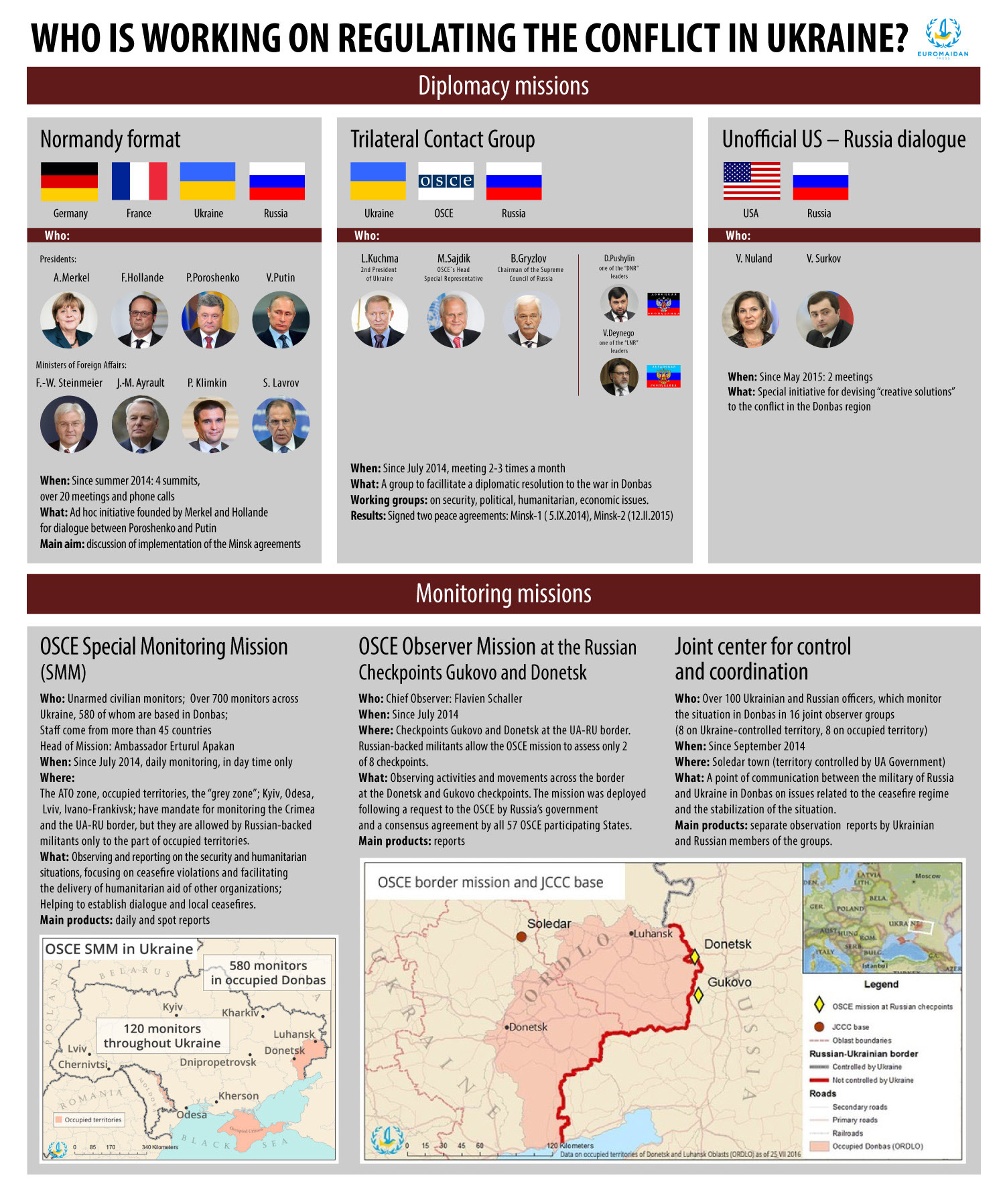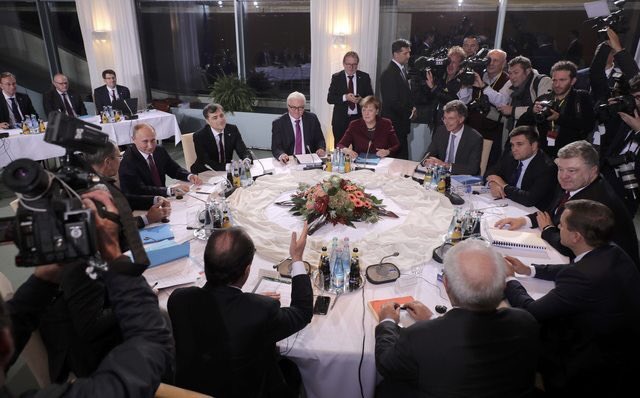The Normandy Four meeting with the participation of Ukraine, Russia, France and Germany took place in Berlin on the night of 19-20 October. The negotiations lasted for 4 hours, accompanied by protests outside the residence of Germany's chancellor Angela Merkel.
https://www.facebook.com/euromaidanpress.en/posts/582152815301858
The main achievement of the meeting is an agreement to create a “roadmap” for implementing the Minsk peace deal, first signed in September 2014 (known as Minsk-1) and then in February 2015 (Minsk-2) after Minsk-1 got so many ceasefire violations.
“Six months ago, nobody wanted to hear about a ‘roadmap,’ but it became possible thanks to the perseverance of the Ukrainian side.
A ‘road map’ foresees consistency and guarantees. Implementing the security conditions, a ceasefire, withdrawing foreign troops, respect for the removal of military equipment, providing easy access for the OSCE, releasing hostages should go before the implementation of the political part.
Also, we agreed that within a month the foreign ministers will meet again to prepare the next meeting of leaders of states,” said the President of Ukraine Petro Poroshenko in his Facebook after the meeting.
Let's take a look at these and other agreements of the Normandy Four meeting one by one.
1. Implementation of security conditions and a ceasefire
So far the security situation is still dangerous in Donbas. In the past 24 hours (from October 19 to October 20), Russian-backed separatists forces attacked Ukrainian army positions in eastern Ukraine 30 times. The ceasefire was violated 21 times in the Mariupol sector, 4 times in the Luhansk area, and 5 times in Donetsk sector. During these attacks, Russian forces used 82mm and 120 mm mortars, 122 mm and 152 mm cannon artillery systems. The Ukrainian headquarter of the Anti-Terrorist Operation records such ceasefire violations by the Russian-backed forces every day.
2. Withdrawal of foreign troops and respect for the removal of military equipment
In September 2016, the agreement on the re-dislocation of military forces in three areas – Stanytsia Luhanska, Zolote, and Petrivske, were reached during the Trilateral contact group meeting in Minsk.
The removal has happened in Zolote and Petrivske. However, Ukrainian side pointed out that pro-Russian forces still violate the ceasefire in Stanytsia Luhanska. According to the speaker of Ministry of Defense Andriy Lysenko, the removal of Ukrainian forces there so far is impossible because of the constant shelling and provocations by the Russian side.
The participants of the Berlin meeting agreed on the re-dislocation of military forces in 4 more areas. So far, the particular places were not mentioned.
3. Expanding the presence of the OSCE mission in the area
So far there is the OSCE Special Monitoring Mission (SMM) to Ukraine in the area and a separate mission which operates at the Russian checkpoints Gukovo and Donetsk. Quite often the OSCE mission reports on the lack of the access to the monitoring areas.
Read also: OSCE SMM deputy chief on why expectations of them are too high
On 20 October 2016, the Normandy Four participants agreed on expanding the OSCE mission in Donbas and giving the observers access to the whole occupied territory of the region, including uncontrolled by the Ukrainian government part of the border with Russia.

So far the mission includes about 700 observers.
Also, the question of sending the OSCE armed police mission (the separate mission with another mandate) to Donbas was discussed in the meeting at Berlin.
President Poroshenko mentioned the possibility of sending of the armed police mission for providing security during possible elections in the area and for the transitional period. Russian president Vladimir Putin talked only about expanding the presence of the OSCE without mentioning an armed mission. The chancellor of Germany Angela Merkel said that the armed police mission can be sent to Donbas, however now the question is not on agenda.
Meanwhile, the representatives of the so-called “Donetsk People's Republic” and “Luhansk People's Republic” are constantly standing against sending the OSCE armed police mission to Donbas.
4. Conducting elections in the occupied Donbas territories
Holding elections in the occupied Donbas is the most sensitive question on the agenda.
Ukrainian society is concerned that conducting elections in the area is a part of the Kremlin’s plan which would allow destabilizing Ukraine from within. In this case, Russia would be officially seen as not part of the conflict and Ukraine’s war against combined Russian-separatists forces in Donbas will be officially considered a civil war. Russia’s proxy militias would be legalized, and in the future members of these militias will likely sit in the Ukrainian Parliament.
During the Berlin meeting, President Poroshenko emphasized that before the elections could happen all the foreign military forces have to be removed from the occupied territories.
According to Poroshenko, during the Berlin meeting the conceptions of the future election and implementing the Frank-Walter Steinmeier formula were discussed. The formula foresees passing the law on giving a special status to Donbas and conducting the elections. The particular date of the elections was not discussed at the meeting.
Read also: Holding elections now will destabilize Donbas
The four ministers of foreign affairs will work on a roadmap of the implementation of the Minsk agreements. The project is expected to be ready at the end of November.
Destined for deadlock?
“The main sense of the Minsk agreements is to continue sanctions against Russia,” wrote Vitaliy Portnikov, a Ukrainian political analyst. According to him, negotiations with the world leaders were needed in order for Putin to avoid international isolation, after sharply critical statements of Germany and France regarding Russia’s support for Bashar al-Assad’s forces, with Merkel suggesting on Tuesday that Moscow was partly responsible for atrocities, citing “Syrian and Russian airstrikes on helpless people, hospitals, and doctors.”
Since the signing of the second Minsk agreements in February 2015, Ukraine and Russia were sharply split on the order of implementation of the pact, with Ukraine insisting that the “political part,” meaning carrying out elections in Donbas and providing it with a special status via changes in Ukraine’s Constitution, providing amnesty for participants of the war, should come after the “security part,” i.e. the establishment of a ceasefire and restoring control of the border. Germany and France have expressed their support for Ukraine in these “security first” demands, with Hollande stating that "the question of security is most important" at a press conference following the talks in Berlin. Meanwhile, over the last year, Putin continued to stick to his “classical line” - Ukraine must implement the political package first, including changes to the Constitution, the law on amnesty, and “direct negotiations” with the Russian mercenaries.
Portnikov is confident that negotiations between the European leaders and Putin will always end up in a deadlock.
“And here the dialog stops because Hollande and Merkel clearly understand that without disarming criminals and a withdrawal of Russian troops, no elections are possible. But Putin understands just as clearly that after the disarmament of the criminals and withdrawal the Russian troops he does not need any elections. He will simply lose Donbas as a leverage of influence on Ukraine,” says Portnikov.
Read more: Red lines Ukraine can’t cross in the Minsk process

